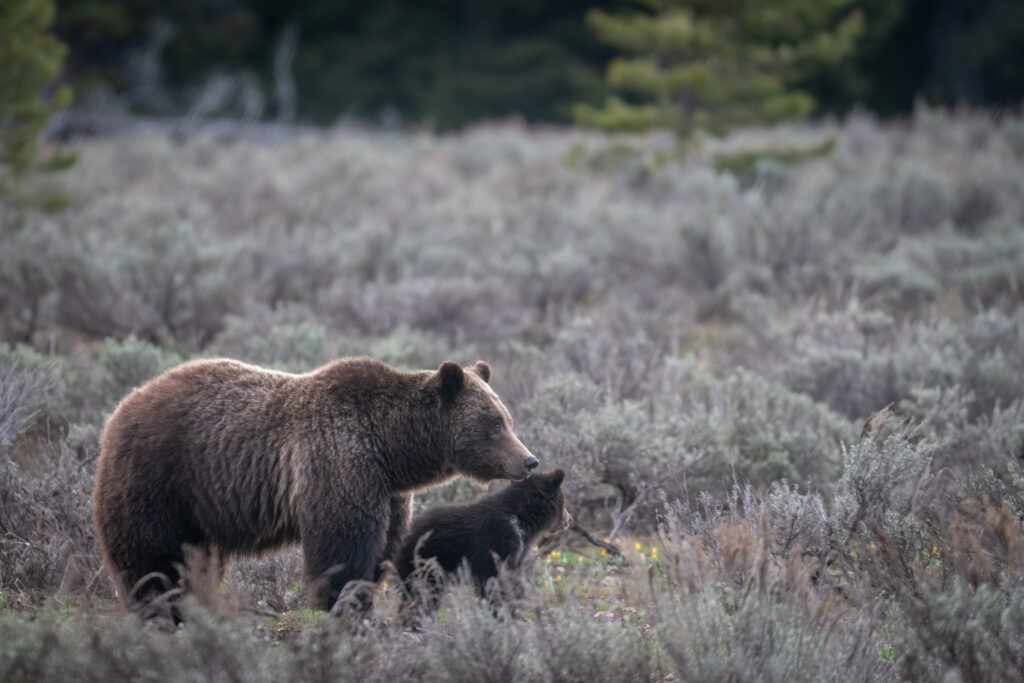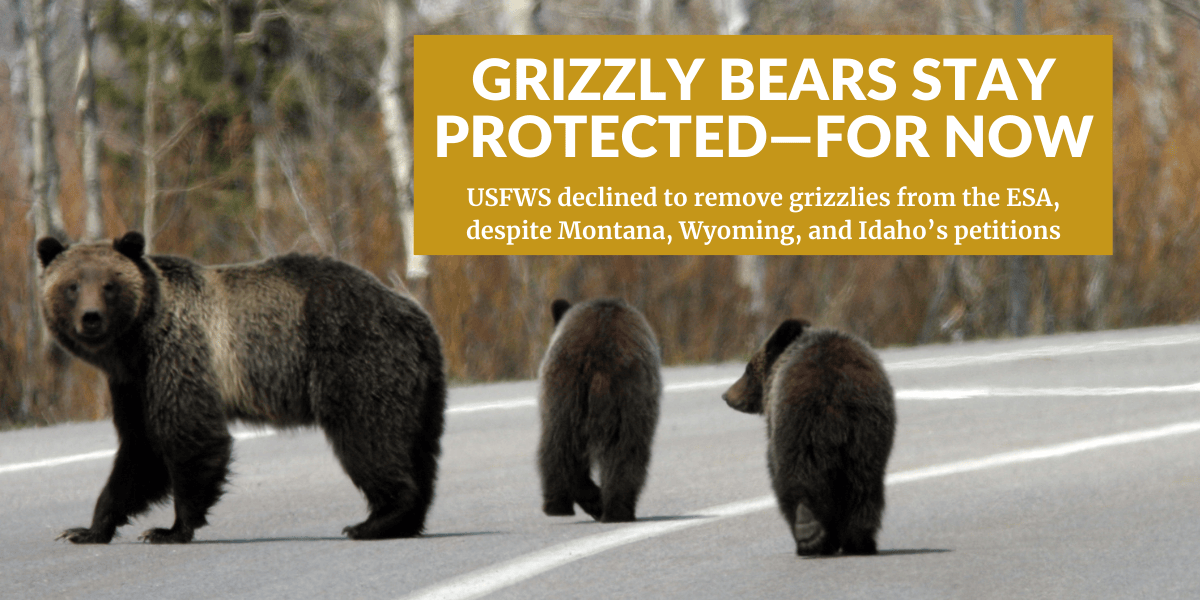Grizzly Bears Stay Protected – For Now
In cautious good news, this week brought a significant development in wildlife conservation: grizzly bears stay protected. The Biden administration declined to remove grizzly bears from the Endangered Species Act (ESA) list, rejecting petitions from Montana and Wyoming to delist the iconic species. Their announcement also resolved a court-ordered settlement with Idaho, which petitioned the U.S. Fish and Wildlife Service (USFWS) to strip protections from all grizzlies in the lower 48.
While this is a positive step toward ensuring the continued survival of grizzly bears, it’s essential to approach the news with cautious optimism.
The good: USFWS concluded that grizzly bears remain threatened by habitat loss, human-wildlife conflict, and climate change. Maintaining ESA protections recognizes the importance of addressing these ongoing threats before delisting is even considered.
The proposed single Distinct Population Segment (DPS) is a positive step toward recognizing the need for connectivity between currently isolated grizzly populations, which often suffer from limited genetic exchange. However, the new DPS map excludes significant portions of these bears’ historic range (they were found everywhere in the Great Plains and West except deserts) and substantial areas of ideal grizzly habitat.
The warning signs: This decision is not without concerning caveats. While the agency declined the petitions from Montana and Wyoming, it “compromised” with a proposal to allow private landowners to kill bears to protect livestock, and without a permit if livestock are in imminent danger.
The USFWS also proposed a new rule that would designate a management area for grizzly populations in Idaho, Montana, Wyoming, and Washington. This plan, while still under review, suggests removing ESA protections for grizzlies outside this area and loosens the restrictions on when grizzlies can be killed.
Our take? Safeguards must remain in place until grizzlies are not only fully recovered but also safeguarded by state-level regulations capable of ensuring their long-term survival. And we, as advocates, must remain watchful as this rulemaking process unfolds.
Narrative Note: What Does “More Tools and Flexibility” Mean?
Word choice with federal and state agencies often signals more than the average reader knows. In defending the proposed rule, outgoing USFWS director Martha Williams described it as providing “more tools and flexibility” for managing grizzly bear populations. Unfortunately, in this context, such language often translates to increased opportunities for lethal measures. States like Montana and Wyoming, in particular, have a track record of prioritizing hunting and lethal predator control over coexistence strategies.
This underscores the need for vigilance. The rulemaking process includes environmental analysis and a public comment period, giving advocates and concerned citizens an opportunity to ensure grizzly bears don’t lose critical protections.
Grizzly bears are an apex predator and a keystone species, playing an essential role in maintaining healthy ecosystems. Yet their survival depends on more than federal protections—it also requires a cultural shift toward coexistence. Human-wildlife conflict remains one of the biggest threats to grizzlies, especially in areas where their habitat overlaps with human activity.
States that petitioned for delisting often fail to invest in proactive measures like bear-proof trash systems, livestock guardian programs, and public education. Instead, they rely on reactive, lethal strategies that exacerbate conflict rather than solve it.

Photo of Grizzly 399 and Spirit by C. Adams, Grand Teton National Park
Focus Your Fight: Remembering Grizzly 399
This news also arrives on the heels of our collective heartbreak over the loss of Grizzly 399, the world’s most famous grizzly bear. At 27 years old, the matriarch captivated millions with her resilience and grace, becoming a symbol of what is possible when people choose to coexist with wildlife. Her death in a vehicle collision serves as a stark reminder of the precariousness of grizzly populations, the role we play in their lives, and the urgent need to protect their future.
The decision to keep grizzly bears on the ESA list is an important victory, but it’s just one step in a much larger fight. This announcement kicks off a rulemaking process that could weaken protections in the future. We must remain engaged, ensuring that public comments and environmental reviews prioritize ethical and science-based strategies centering coexistence.
In December, 15 national, regional, and state environmental, tribal, and animal welfare groups filed a petition to the USFWS to adopt a new approach to recovering grizzly bears in the U.S. Northern Rockies. Based on a new science-based report by Dr. Christopher Servheen, the former USFWS Grizzly Bear Recovery Coordinator who served in that role from 1981-2016, the report details site-specific management actions to aid in the bears’ recovery and calls for a new approach to managing the bears as one unified population with natural connectivity between ecosystems rather than continuing with the current practice of managing isolated populations of bears. As you advocate for these iconic bears, lift up this research and its conclusions in your advocacy.
Grizzlies symbolize the wildness and resilience of North America’s landscapes. To honor Grizzly 399’s legacy, let’s commit to advocating for a future where grizzlies thrive. We can start by participating in the upcoming rulemaking process, advocating for state-level regulations that prioritize coexistence, and supporting organizations working to protect grizzly habitats.
How You Can Help Grizzly Bears Stay Protected
- Stay informed about the USFWS rulemaking process and participate in the public comment period.
- Show up at the meetings: FWS will present more details about the decision at several public meetings later this month. They include:
- Jan. 28, 2025: Missoula, at the Hilton Garden Inn, 3720 N. Reserve St. Information meeting 3-5 p.m., public hearing 6-8 p.m. MST
- Jan. 29: Coeur d’Alene, ID. Information meeting 3-5 p.m., public hearing 6-8 p.m. PST
- Jan. 30: Virtual meeting https://www.fws.gov/grizzlyrulemaking
- 6-8 p.m. MST
- Feb. 10: Cody, WY. Information meeting 3-5 p.m., public hearing 6-8 p.m. MST
- Show up at the meetings: FWS will present more details about the decision at several public meetings later this month. They include:
- Advocate for ethical, science-based management strategies centering coexistence at the state level—many states have wildlife commission meetings this month.
- Support organizations working to promote coexistence and protect grizzly habitats.
The fight for grizzly bears is far from over. Let’s honor Grizzly 399 and her legacy by ensuring these incredible creatures continue to roam wild and free for generations to come.

